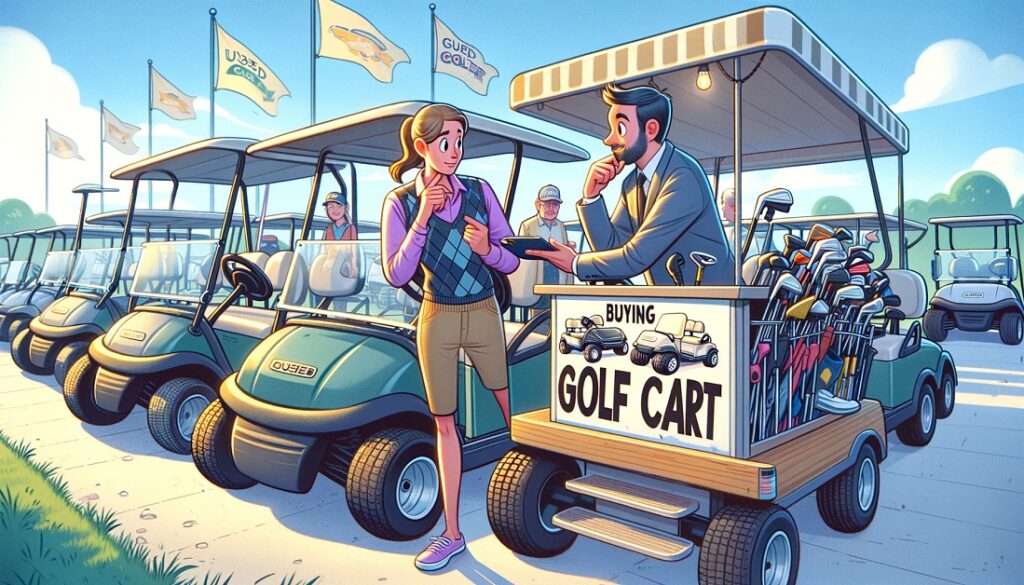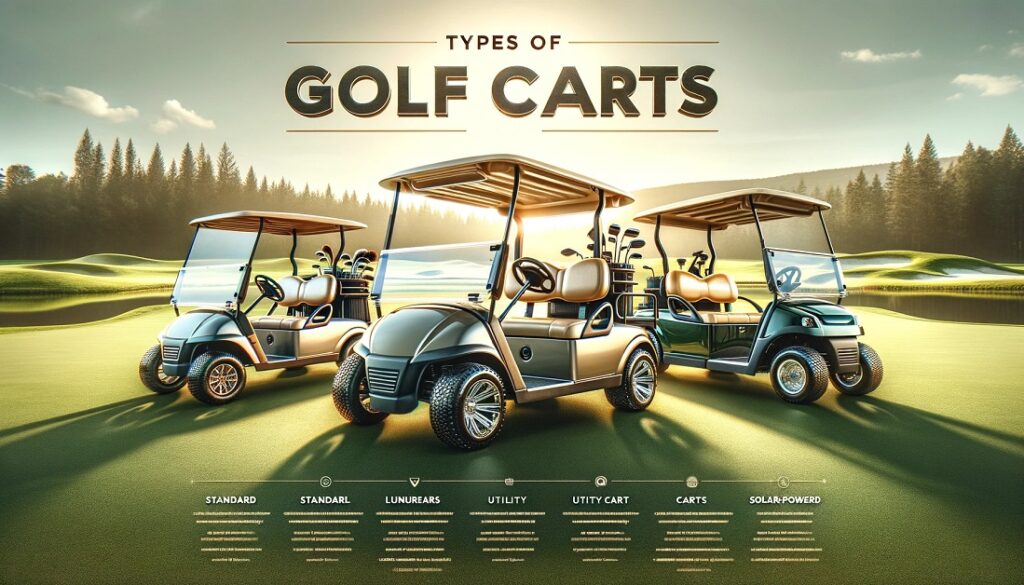Golf carts are the unsung heroes of neighborhoods, retirement homes, and golf courses all around the country. They’re low-maintenance, environmentally beneficial modes of transportation that are ideal for leisurely travel. However, purchasing a used golf cart’s is akin to traveling into the Wild West; you never know what you’ll get. Hidden flaws such as worn-out batteries, shaky suspension, or electrical difficulties can turn a great deal into a financial nightmare. As someone who has learned the hard way, allow me to assist you through the minefield of secondhand golf cart shopping. With some clever suggestions and insights, you can drive away into the sunset with a nice set of pre-owned wheels that won’t leave you stranded on the back nine. In this guide we discuss how to buying a used golf cart so, without further delay let’s start
Table of Contents
ToggleWhy Buy A Used Golf Cart?
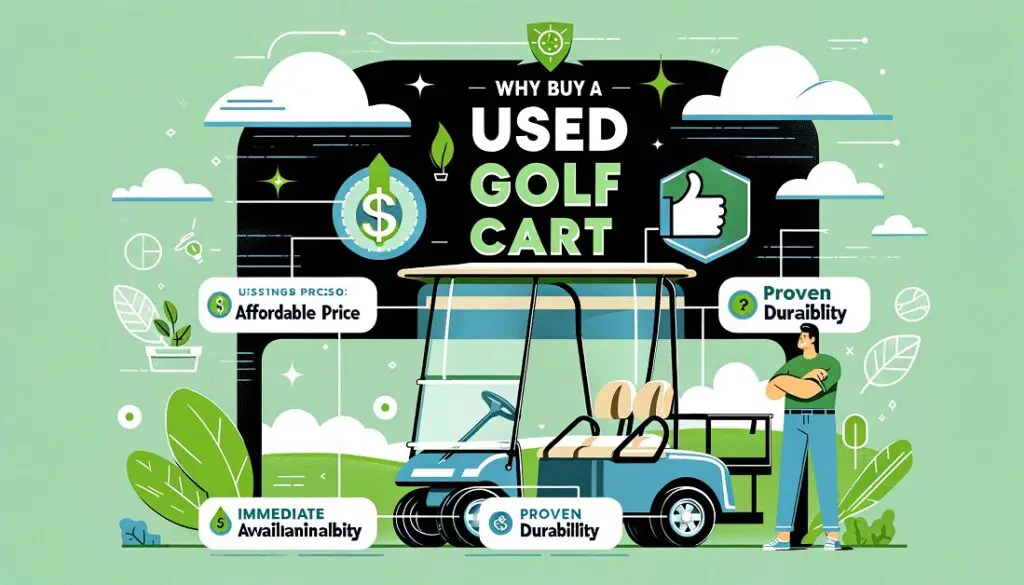
There are several compelling reasons to buy pre-owned golf carts. For starters, used carts can be a huge savings over brand-new units, frequently costing 50% or more. If you’re on a limited budget or like to spend your hard-earned money wisely, the used market is full of opportunities. Furthermore, golf carts aren’t exactly on the leading edge of automotive innovation; the dependable, burning love you had your eye on is likely to have many good years left in her, even after some mild pre-owned affection.
And also make a detailed guide for you about Golf Cart Cost if you want to know about it so, never miss out. Anyways now get back to our topic
How To Buy A Used Golf Cart
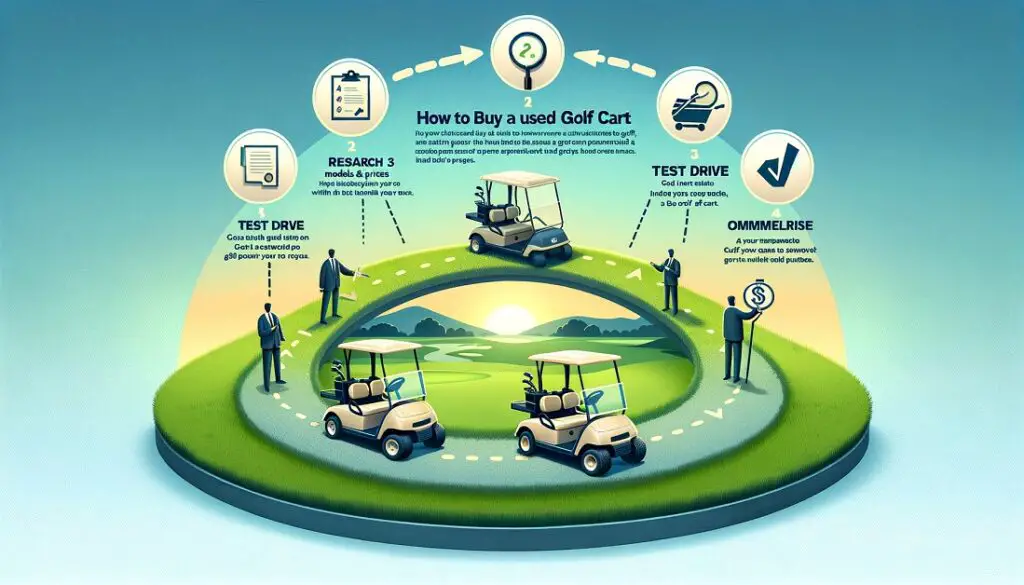
Now that you’re motivated to join the used golf cart’s army, it’s time to devise a strategy. To begin, explore online classifieds such as Craigslist and Facebook Marketplace for leads. But don’t stop there; check with local courses of golf, clubs, and retirement homes as well, as people are constantly wanting to dump their carts.
After you’ve identified some promising leads, it’s critical to conduct a thorough inspection. Fresh batteries are the heart of these eco-friendly animals, so have the vendor charge them up and take a voltage reading; anything less than 50% capacity is cause for alarm. Next, go full Columbo on the chassis and body, looking for corrosion, dents, and frame damage. Wiggle all the mechanisms, including the steering linkage, brake cables, and suspension components, to ensure smooth operation and no excessive play.
Things To Must Know Before Buying A Used Golf Cart
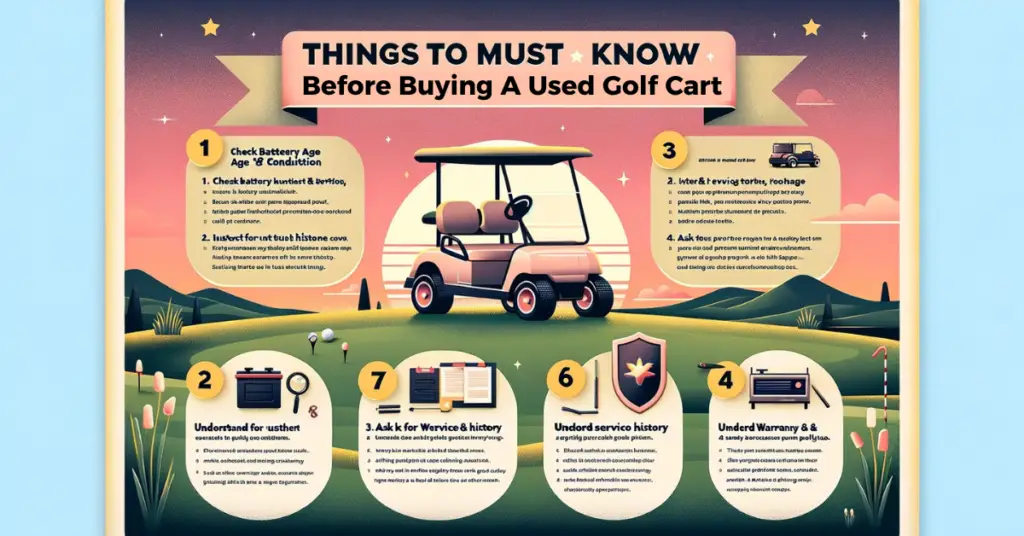
How Old Is The Golf Cart?
When it comes to golf carts, age isn’t just a number; it’s also an important data element. An older cart is more likely to have worn components and require future repairs. Most have a useful life of 4-6 years under normal operating circumstances before they fail. Anything under four years old with acceptable mileage is ideal, but don’t rule out well-maintained older jewels. Just make sure you include aging in your pricing estimates and maintenance budget.
Make
Golf carts, like automobiles, bear weight based on their reputation and quality. The major name of golf cart brands, such as Club Car, EZ-GO, and Yamaha, are the crème de la crème and retain their worth better than off-brand products. Parts and services are also more widely available. However, if the cart passes the examination, don’t completely disregard lesser-known names; you can sometimes find incredible savings.
Model
Golf cart models vary by manufacturer, ranging from basic buggies to fully equipped luxury extras such as bespoke seats, mini-fridges, and loud music systems. Naturally, the nicer models with all the bells and whistles cost more. Be honest about your actual needs and avoid overpaying for a model with a lot of options.
Serial Number
This modest string of numbers and letters is a goldmine for learning about a secondhand cart’s history. The serial number, or VIN, can provide information such as the manufacturer, model year, and equipment specifications. It also allows you to search for any outstanding recalls or technical service bulletins from the manufacturer. Only purchase a used cart after deciphering the serial number; it may indicate previous issues or the need for repairs.
Battery Condition
Checking the battery condition is an important step. First, inspect the tops for cracks, bulges, or leaking electrolytes; these are condemned batteries ready to collapse. Next, have the vendor fully charge the pack and measure the voltage across each battery using a multimeter or cart voltage meter. Anything less than 6 volts per battery is cause for concern, and readings below 5 volts suggest that the battery needs to be replaced soon. When buying, a cart ensure it comes with a reliable charger for convenience and long-term battery health
You should also load-test the batteries after they have been charged. This uses a discharge current that simulates real-world use to ensure that the battery is not simply storing a surface charge. Values less than 75% of the authorized amp-hour capacity indicate weaker batteries that will not run your cart for an extended duration.
If the batteries are more than 4-5 years old or fail the tests, be prepared to figure in reasonable battery pricing – a full new 6-8 battery pack might easily cost $500-800 installed from a golf cart shop. Neglecting rotten batteries is a formula for becoming stranded, therefore it’s better to pay for new power now than later!
Inspect The Body And Tires
While all of the mechanical and electrical tests may pique your interest, don’t forget to thoroughly inspect the cart’s body and tires as well. Unsightly dings and dents will not always affect performance, but they can detract from aesthetic appeal. More importantly, any significant rust holes or frame damage are severe red flags that should not be overlooked.
Run your hands around the chassis rails, floors, and body panels, looking for any rotting, rot-through spots, or crusty scale. Lift any plastic interior trim pieces and check for concealed corrosion underneath. Stressed frames caused by excessive misuse or overloading provide a safety issue and are prone to catastrophic failure.
The tires are your only point of contact with the ground, so make sure they still have enough tread life to be roadworthy. Dry rot and weather cracking are also common issues with aged rubber that has been roasted in the sun for too long. Inspect for any bulges, flat patches, or deterioration that may necessitate premature replacement. Most golf courses require shutting cart tires over aggressive treads, so keep that in mind when pricing replacements.
Explore: You can also read more about golf cart tire pressure in our detailed guide.
Begin your braking inspection by pressing the park and attempting to push the cart. It should firmly resist rolling even at a small inclination. Any movement suggests an issue with the parking. Next, get a friend to help you test the foot pedal. It should feel hard but not completely flat, and the cart should come to a smooth halt without pushing to one side. Spongy or low pedals may indicate brake fluid, cylinder, or cable issues.
Do not forget to inspect the physical braking components on all four wheels. There should be enough pad/shoe material life left, with no cracking, glazing, or contamination. The brake backing plates and caliper bodies should be straight, with no bends or deformation. When you apply the brakes, all of the mechanical linkages and cables must perform smoothly and without binding
Test Drive
Find a decent long stretch of road and open it up, feeling for any weird vibrations, noises, or slow acceleration as you gain speed. The steering wheel should respond crisply, without undue play or wandering. Brake smoothly at varying speeds to provide consistent, firm stops. Carefully navigate a few curves to ensure stability and suspension compliance over bumps.
Don’t forget to test all of the other features as well, such as turning on the signal lights, sounding the horn, and fiddling with any amenities like coolers or stereos. The goal is to simulate your typical driving conditions and identify any gremlins. If something seems off, it could be an opportunity to renegotiate the price.
An enclosed space, such as a garage or large parking lot, is good for testing the cart in both forward and reverse. Look for hesitations, bad radius turns, or warning lights on the dashboard. When finished, allow it to idle shortly before properly inspecting it for any leaks or smoke that may have accumulated while underway.
Does It Have the Features You're Looking For?
With the most crucial examination issues completed, it’s time to take a step back and consider whether this golf cart offers the features and functionality you genuinely desire and require. Desires can vary from basic transit to a fully equipped luxury cruiser.
Prepare an honest list of your must-have goods ahead of time, such as seating capacity, storage space, power accessories, and so on. A basic two-seater cart is ideal for single riding, but if you’re transporting the entire family, quad seats and a flip-down rear-facing bench may be required. Cooler and storage sections are ideal for keeping drinks cool and storing supplies.
Then there are other features like sun canopy toppers, windshields, high-resolution headlamps and taillights, luxury audio systems, and more. These features raise the price of your cart, but depending on your intended use, they can improve its functionality and enjoyment. If you routinely drive through mountainous terrain while loaded down, an improved motor with additional torque may be desirable.
Make Sure The Golf Cart Is Not Damaged?
First, thoroughly examine the entire exterior for signs of serious impact damage. A previously crashed cart may have misaligned body panels, broken or stressed plastic components, and blitzed-up chalky paint. Inspect underneath as well, looking for bent or damaged frame components that may jeopardize structural integrity.
Then, take a detailed look at the front and rear end assemblies, which are susceptible to impact damage. Red flags include bent or fractured control arms, tie rods, axles, and leaf springs. The steering rack, gearbox, and brakes should all be thoroughly inspected for leaks or damage. Any evident collision repair work raises the possibility of other issues.
If the golf cart passes our comprehensive damage inspection with flying colors, you can feel a little better about its structural integrity. However, any issues should be addressed or negotiated to account for repair expenses before signing the contract.
Is The Selling Price Worth It or Not?
To determine whether asking price is reasonable, some due diligence is required. To establish an acceptable foundation, look into the prices of similar make, model, and year carts in your area. Online ads, dealer listings, and pricing guides will help you get a good notion of the going rate.
However, you should not base your decision just on that number. An accurate valuation should take into account the exact condition, mileage, battery age/health, included accessories, and general maintenance history. A cart with new batteries, tires, and dealer service records is naturally more valuable than one that has been ignored.
The idea is to find a fair market price that leaves enough money for any necessary part replacements or upgrades after purchase. With some shrewd negotiation abilities, you can get a terrific price.
Pros And Cons Of Buying Used Golf Carts

Pros
Significant Cost Savings: One of the key benefits of buying a used golf cart is the possibility of significant savings. Well-maintained used models are frequently available for 50% or more than the cost of buy a new cart.
Avoidance of Immediate Depreciation: Unlike new vehicles, which lose significant value as soon as they are driven off the lot, carts have already gone through the early depreciation period.
Maintenance: With regular maintenance, quality golf carts may last for many years and provide dependable service. By choosing a low-mileage, well-serviced unit, you may expect to have many more years of dependable operation for a fraction of the price of a new cart.
Access to Premium Features and Brands: The used market opens up a world of options, allowing you to experiment with premium features, accessories, and even top-tier brands that would have been financially prohibitive when acquiring a new cart.
Environmental Sustainability: Using the pre-owned market to extend the life of existing golf carts helps to ensure environmental sustainability.
Cons
Lack of Comprehensive Warranty Coverage: Unlike new golf carts, which normally include a comprehensive manufacturer’s warranty, secondhand versions frequently lack such protection. Any existing faults or component failures become the complete financial responsibility of the new owner on the day of purchase, which may result in unanticipated repair expenditures.
Uncertainty about Maintenance History: Even with a comprehensive pre-purchase inspection, identifying every potential problem and precisely projecting the remaining lifespan of a used golf cart’s components can be difficult.
Potential for Hidden Faults: Even with rigorous inspection, certain underlying faults or defects may go undetected until after the transaction is completed.
Limited Availability of Desired Specifications: While the used market has a diverse selection of golf carts, finding a pre-owned model that precisely matches your desired specifications, such as specific features, color, or accessories, may be more difficult than purchasing a new cart built to your exact preferences
When buying a used golf cart, here are some important things to look for, along with tips for buying a used golf cart, such as checking the condition of the EZGO model and ensuring you receive a proper bill of sale
Additional Things To Consider When Buying Used Golf Carts

While we’ve covered the most important inspection points and buying advice, there are a few other things to consider when looking for a used golf cart. Consider these things to ensure you make an informed decision.
Warranty
While reputable used golf carts may carry a portion of the original factory warranty, you are usually responsible for any difficulties that arise after you purchase them. When possible, ask about an affordable extended warranty that covers major components for a year or two as an added layer of security.
For new cart purchases, you should expect complete bumper-to-bumper coverage included in the price. Typical warranties may include 4 years/8 volts of battery coverage and 3 years on the rest of the cart. Don’t be hesitant to negotiate for longer warranty terms; those extra years of worry-free ownership are important.
Customization
Golf cart ownership brings up a world of modification options to properly personalize your cruiser. The only limit is your budget and imagination when it comes to basic modifications like beautiful steering wheels and seating, as well as more substantial ones like sound systems, lighting packages, and lift kits.
When purchasing used, thoroughly verify to ensure that any existing accessories or customizations have been professionally installed. Amateur work can pose safety risks. Otherwise, having a few desirable accessories could boost your enjoyment factor without incurring the full cost of adding them aftermarket.
Shop For The Best Price
Whether buying used or new, wise buyers should constantly look into several options to discover the best value for their ideal golf cart. Check online classifieds such as Facebook Marketplace and Craigslist for used models, but also broaden your search by contacting local clubs, courses, and communities where owners are looking to sell.
Prices might vary greatly between private party sales and dealers, so obtain many quotations to haggle successfully. Don’t be hesitant to make offers or ask about discounts – golf cart pricing is typically flexible, especially on pre-owned vehicles.
With new purchases from dealers, you have more bargaining power than you realize. Use competitive quotations, order period discounts, or leftovers from last year’s model run. It also doesn’t hurt to inquire about bonuses, rebates, or other special offers to optimize your savings.
Ensure That There Is No History Of Accidents
As previously noted, it is vital to thoroughly inspect every used golf cart for signs of prior damage or extensive repairs caused by accidents or collisions. Even with new paint and elbow grease, collision repair firms cannot conceal everything.
Request maintenance records, if accessible, as these may disclose previous incidents. Examine the chassis rails, suspension components, and body mounts carefully for any bent or modified parts. Misaligned gaps in body panels and stress cracks may also indicate underlying deterioration.
With new models, you can avoid potential accidents straight away. The cart will be factory-fresh, with no hidden skeletons in the closet. Simply accept delivery and don’t add any additional dents or dings!
Final Thought

Now I wrap up my thoughts so buying a used golf cart is a great option for those who want a cart at hi cheap price. But you never take a complete procedure which I tell you to take lightly and when you inspect a golf cart and find any kind of fault in it so do not be disappointed these faults create a chance to negotiate a better price. But one thing I told you before this is time time-consuming process you must have the patience to find a good golf cart that meets all of your requirements so never irritate it.
As much as you can a good research for a cart you can find ideal and reliable transportation but it depends on your efforts and patience. Simply go in with knowledge and realistic expectations. Before you know it, you’ll be cruising around the neighborhood or golf course with a proud smile, waving to all of the other carts who are envious of your slick new ride.

